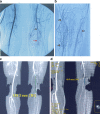Improvement in Blood Supply After "Heparin-Dextran" Therapy in Patients of Buerger's Disease with Critical Limb Ischemia
- PMID: 24465103
- PMCID: PMC3900760
- DOI: 10.1007/s12262-012-0537-1
Improvement in Blood Supply After "Heparin-Dextran" Therapy in Patients of Buerger's Disease with Critical Limb Ischemia
Abstract
Alleviating the agonizing pain of critical limb ischemia (CLI) in patients of Buerger's disease (BD) has been challenging, due to lack of definitive treatment; "Heparin-Dextran" infusion has been tried in this study. Assessment of clinical improvement and vascular changes following therapy. Patients with CLI admitted to emergency surgical ward were studied prospectively. BD was diagnosed by Shionoya's criteria, and confirmed by digital subtraction angiography (DSA). Heparin and Dextran intravenous infusion was administered for 10 days. Severity of rest pain, ischemic changes in the feet, claudication distance and ankle brachial index (ABI) were estimated prior to therapy, at completion and 3 weeks after therapy. Vascular changes were assessed by CT angiography (CTA) performed prior to and 3 weeks after therapy. Twenty consecutive patients were studied. Successful hemodilution reflected by decreased hematocrit (37.4 % to 32.6 %, p < 0.05) and increased mean ABI (0.46 to 0.83, p < 0.01), improved rest pain in 75 % patients (p < 0.001), increased claudication distance in 94 % (p < 0.05) and ulcers healing in 70 % patients. CTA revealed recanalised vessels (decreased length of occluded segments) in 10 (50 %, p = 0.005), increased collaterals in 12 (60 %, p < 0.01) and improved distal run-off in 13 (65 %, p < 0.01) patients. "Heparin-Dextran" therapy in patients of CLI from BD improves tissue perfusion by increasing collaterals and recanalisation of vessels, resulting in significant relief from rest pain and clinical improvements. CTA is as efficacious as DSA for evaluation of BD.
Keywords: Angiography; Buerger’s disease; Critical limb ischemia; Heparin-Dextran.
Figures



Similar articles
-
Treatment of thromboangiitis obliterans (Buerger's disease) by intramuscular gene transfer of vascular endothelial growth factor: preliminary clinical results.J Vasc Surg. 1998 Dec;28(6):964-73; discussion 73-5. doi: 10.1016/s0741-5214(98)70022-9. J Vasc Surg. 1998. PMID: 9845647
-
A prospective feasibility study of duplex ultrasound arterial mapping, digital-subtraction angiography, and magnetic resonance angiography in management of critical lower limb ischemia by endovascular revascularization.Ann Vasc Surg. 2007 Jul;21(4):443-51. doi: 10.1016/j.avsg.2006.08.005. Epub 2007 Feb 26. Ann Vasc Surg. 2007. PMID: 17628263
-
Administration of Adult Human Bone Marrow-Derived, Cultured, Pooled, Allogeneic Mesenchymal Stromal Cells in Critical Limb Ischemia Due to Buerger's Disease: Phase II Study Report Suggests Clinical Efficacy.Stem Cells Transl Med. 2017 Mar;6(3):689-699. doi: 10.5966/sctm.2016-0237. Epub 2016 Oct 5. Stem Cells Transl Med. 2017. PMID: 28297569 Free PMC article. Clinical Trial.
-
Diagnostic criteria and treatment of Buerger's disease: a review.Int J Low Extrem Wounds. 2006 Jun;5(2):89-95. doi: 10.1177/1534734606288817. Int J Low Extrem Wounds. 2006. PMID: 16698911 Review.
-
Omentopexy for limb salvage in Buerger's disease: indications, technique and results.J Postgrad Med. 2001 Apr-Jun;47(2):137-42. J Postgrad Med. 2001. PMID: 11832609 Review.
Cited by
-
Comparative Analysis of Transcriptome Profiles in Patients with Thromboangiitis Obliterans.Genes (Basel). 2023 Dec 21;15(1):19. doi: 10.3390/genes15010019. Genes (Basel). 2023. PMID: 38275601 Free PMC article.
-
Optimal hematocrit in an artificial microvascular network.Transfusion. 2017 Sep;57(9):2257-2266. doi: 10.1111/trf.14213. Epub 2017 Jul 5. Transfusion. 2017. PMID: 28681482 Free PMC article.
References
-
- Nigam R, Narayanan PS, Sharma SR, et al. Thromboangiitis obliterans and atherosclerotic obliterans as a cause of limb ischemia in Delhi. Ind J Surg. 1980;42:9–15.
LinkOut - more resources
Full Text Sources
Research Materials
Miscellaneous
